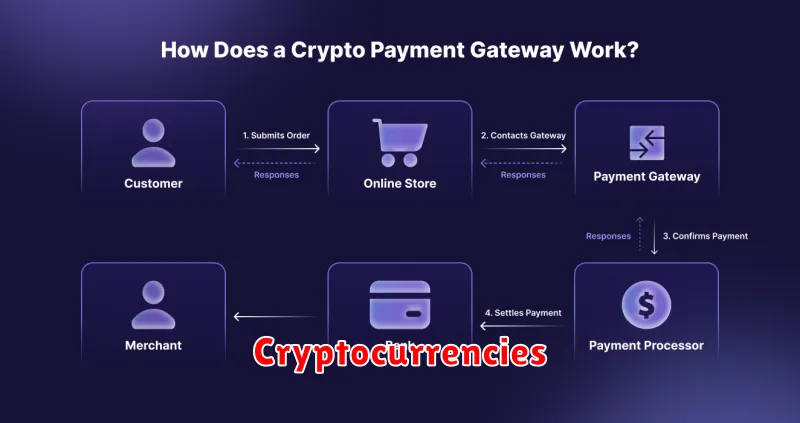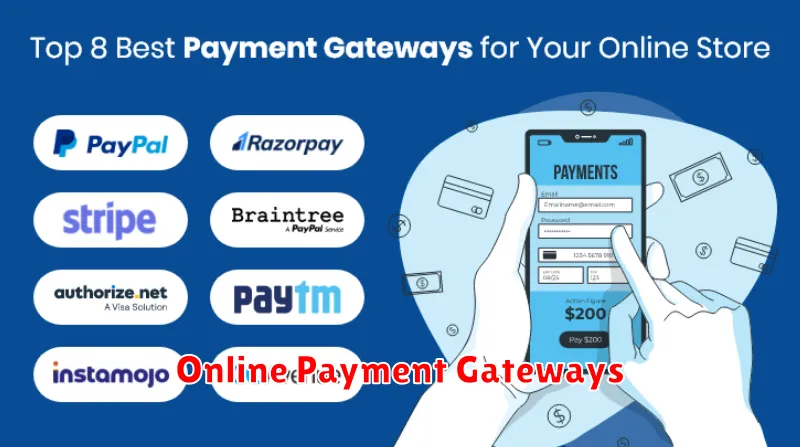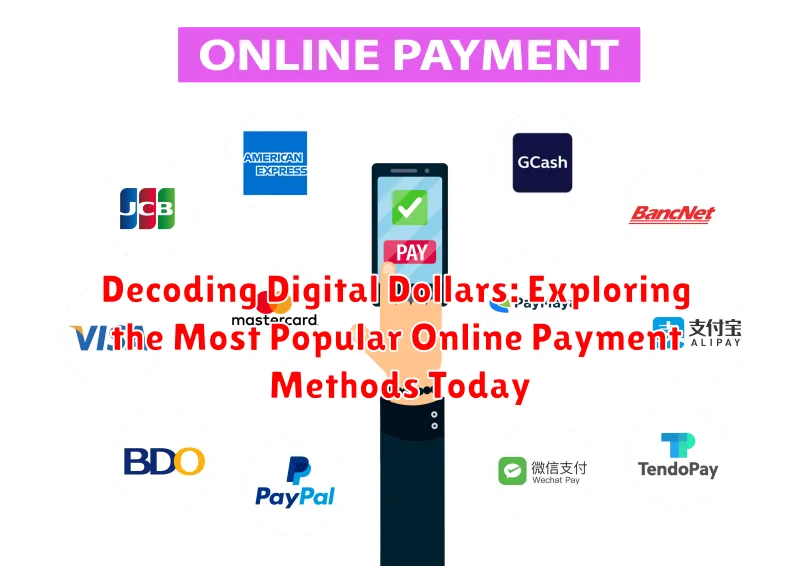In today’s rapidly evolving digital landscape, online payment methods have become an indispensable part of commerce. Understanding the various digital dollar options available is crucial for both businesses and consumers. This article, “Decoding Digital Dollars: Exploring the Most Popular Online Payment Methods Today,” delves into the intricacies of the most prevalent online payment methods, providing a comprehensive overview of their functionalities, benefits, and potential drawbacks. From established giants like credit cards and PayPal to emerging technologies such as mobile wallets and cryptocurrencies, we will explore the dynamic world of digital transactions and how they are shaping the future of finance.
Navigating the myriad of online payment options can be daunting. This article aims to simplify the process by providing a clear and concise explanation of each method. We will examine the security features, transaction fees, and user experience associated with each digital payment method, empowering you to make informed decisions about which options best suit your needs. Whether you are a seasoned online shopper or a business owner looking to optimize your payment gateway, this exploration of digital dollars will equip you with the knowledge to navigate the complex world of online transactions effectively.
Credit and Debit Cards
Credit and debit cards remain a cornerstone of online transactions. Credit cards offer a line of credit, allowing users to borrow funds for purchases, which are then repaid with interest. Debit cards, conversely, draw funds directly from a linked checking account.
Both card types utilize a card number, expiration date, and CVV code for secure online payments. The underlying technology often involves payment gateways and processors that facilitate the transfer of funds between the buyer and the seller.
Advantages include widespread acceptance and robust consumer protection measures. However, potential downsides involve interest charges for credit cards and the risk of fraud if card details are compromised.
Digital Wallets (e.g., Apple Pay, Google Pay)
Digital wallets offer a convenient and secure way to make contactless payments in stores, online, and in apps. They store virtual versions of your credit and debit cards, eliminating the need to carry physical cards. Services like Apple Pay and Google Pay utilize near-field communication (NFC) technology to transmit payment information wirelessly.
To use a digital wallet, you simply add your card details to the app. During checkout, you hold your device near the payment terminal. Authentication is typically done through biometric verification (fingerprint or facial recognition) or a passcode, adding an extra layer of security. Digital wallets also often tokenize card information, meaning the actual card number isn’t shared with the merchant, further protecting against fraud.
The increasing popularity of digital wallets can be attributed to their speed, convenience, and enhanced security features. They streamline the checkout process and reduce the risk of physical card loss or theft.
Mobile Payment Apps (e.g., Venmo, Zelle)
Mobile payment apps facilitate quick and easy money transfers directly between individuals. These apps typically link to a user’s bank account or debit card and allow for seamless transactions through a mobile interface. Venmo, for example, is popular for its social features, allowing users to share payment details and add notes, making it ideal for splitting bills and casual transactions. Zelle, on the other hand, focuses on speed and security, transferring funds directly between linked bank accounts without holding balances within the app itself.
While both apps offer convenient ways to transfer money, they differ in their approach. Venmo emphasizes social interaction and provides a platform for recording transactions with friends and family. Zelle prioritizes fast, secure bank-to-bank transfers, making it suitable for situations requiring immediate payment. Choosing between the two depends on individual preferences and transaction needs.
Buy Now, Pay Later (BNPL) Services
Buy Now, Pay Later (BNPL) services have emerged as a popular payment option for online shoppers. These services allow consumers to split purchases into smaller, interest-free installments, typically paid over a few weeks or months. BNPL offers a flexible alternative to traditional credit cards, particularly for younger demographics.
BNPL services integrate smoothly with online checkout processes. Customers usually select the BNPL option at checkout and are often approved instantly after a quick credit check. Key benefits include the ability to manage budgets effectively, especially for larger purchases, and avoid accruing high interest charges typically associated with credit cards, provided payments are made on time.
However, it’s crucial for consumers to understand the terms and conditions of BNPL agreements. Late payment fees can be significant, and repeated late payments can negatively impact credit scores. While the short-term, interest-free aspect is appealing, responsible usage is essential to avoid accumulating debt.
Cryptocurrencies

Cryptocurrencies represent a decentralized digital payment method, leveraging cryptography for secure transactions and operating independently of traditional banking systems. Bitcoin, the most prominent example, paved the way for a multitude of other digital currencies, each with varying functionalities and features.
Transactions are recorded on a public, distributed ledger known as a blockchain, enhancing transparency and immutability. While offering potential benefits like lower transaction fees and increased privacy compared to traditional methods, cryptocurrencies also come with inherent volatility and regulatory uncertainties.
Key Considerations:
- Volatility: Cryptocurrency values can fluctuate significantly.
- Security: While blockchain technology is secure, individual wallets and exchanges can be vulnerable.
- Regulation: The regulatory landscape for cryptocurrencies is constantly evolving.
Bank Transfers
Bank transfers represent a cornerstone of online payments, facilitating direct movement of funds between bank accounts. This method is often favored for its inherent security and established infrastructure.
Key advantages of bank transfers include high transfer limits, making them suitable for large transactions, and robust security measures minimizing the risk of fraud. They also offer direct payment without third-party intermediaries, streamlining the payment process.
However, bank transfers also present some challenges. Processing times can be slower compared to other digital payment methods, sometimes taking several business days. The lack of instant confirmation can be inconvenient for time-sensitive transactions. Furthermore, some banks may impose transaction fees, adding to the overall cost.
Different types of bank transfers exist, including wire transfers, often used for international payments, and ACH transfers (Automated Clearing House), common for recurring domestic payments. Understanding these variations can help businesses and individuals choose the most suitable option for their needs.
Prepaid Cards
Prepaid cards offer a tangible alternative to traditional banking and credit cards. These cards are loaded with a specific amount of money and can be used for online and in-person purchases wherever the card’s network (e.g., Visa, Mastercard) is accepted. Prepaid cards are particularly useful for those who may not have access to traditional banking services or prefer to budget with a fixed amount.
There are different types of prepaid cards, including general-purpose reloadable cards, gift cards, and travel cards. General-purpose reloadable cards function much like debit cards and can be reloaded with funds as needed. Gift cards are typically one-time use and are designed for specific retailers or merchants. Travel cards are preloaded with a designated currency and can be used internationally.
One key benefit of prepaid cards is their enhanced security. Since they are not linked directly to a bank account, the potential damage from fraud is limited to the balance on the card. However, it’s crucial to register the card to benefit from consumer protection features.
Peer-to-Peer (P2P) Payment Platforms
Peer-to-peer (P2P) payment platforms have revolutionized how individuals exchange money, offering a convenient alternative to traditional methods like cash or checks. These platforms allow for direct transfers between individuals using their mobile devices or computers.
Typically, users link their bank accounts, debit cards, or credit cards to a P2P app. They can then send or receive money from other users on the platform with just a few taps. Speed and convenience are key advantages, with transactions often completing almost instantly.
Popular examples of P2P platforms include Venmo, Zelle, and Cash App. These platforms are frequently used for splitting bills, repaying friends, or making small purchases. Many platforms also offer additional features such as the ability to request funds or even invest.
While generally secure, users should be aware of potential security risks. Using strong passwords and being cautious of phishing scams are essential for safe P2P transactions. Understanding any transaction fees associated with the platform is also important.
Online Payment Gateways

Online payment gateways act as intermediaries between businesses and customers, facilitating secure online transactions. They securely authorize and process payments, ensuring funds are transferred smoothly from the customer’s account to the merchant’s account.
Think of them as the digital equivalent of a physical point-of-sale terminal. When a customer makes a purchase online, the payment gateway encrypts sensitive payment information, such as credit card details, and transmits it securely to the payment processor.
Key players in the online payment gateway space include companies like PayPal, Stripe, and Square. These platforms offer a range of features including fraud prevention tools, recurring billing options, and support for multiple payment methods.
Benefits for businesses using online payment gateways include increased efficiency in processing payments, reduced risk of fraud, and improved customer experience through streamlined checkout processes. They also offer access to a wider customer base by enabling acceptance of various payment types.
The Future of Online Payments
The landscape of online payments is in constant flux, driven by evolving consumer demands and technological advancements. Several key trends are shaping the future of how we transact digitally.
Biometric Authentication is poised to become increasingly prevalent. This includes fingerprint scanning, facial recognition, and even voice recognition, offering enhanced security and a seamless user experience.
Invisible Payments are gaining traction, aiming to make transactions frictionless. Imagine a scenario where your groceries are automatically paid for as you leave the store, eliminating the need for traditional checkout lines.
The Internet of Things (IoT) will further integrate payments into our daily lives. Connected devices, from refrigerators to cars, could initiate and complete transactions autonomously.
Cryptocurrency and blockchain technology continue to mature, potentially revolutionizing how value is transferred and stored. While widespread adoption faces hurdles, the underlying technology offers intriguing possibilities for increased security and transparency.
Artificial intelligence (AI) and machine learning will play a crucial role in fraud prevention and personalized payment experiences. These technologies can analyze vast amounts of data to identify suspicious activity and tailor recommendations based on individual spending habits.

